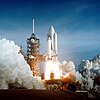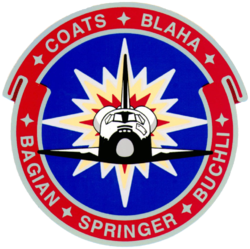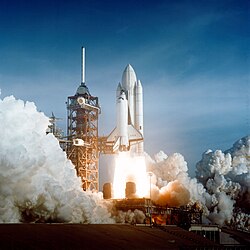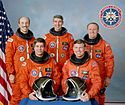STS-29
| Missionsemblem | |||
|---|---|---|---|
 | |||
| Missionsdaten | |||
| Mission | STS-29 | ||
| NSSDCA ID | 1989-021A | ||
| Besatzung | 5 | ||
| Start | 13. März 1989, 14:57:00 UTC | ||
| Startplatz | Kennedy Space Center, LC-39B | ||
| Landung | 18. März 1989, 14:35:50 UTC | ||
| Landeplatz | Edwards Air Force Base, Bahn 22 | ||
| Flugdauer | 4d 23h 38m 50s | ||
| Erdumkreisungen | 80 | ||
| Bahnhöhe | 341 km | ||
| Bahnneigung | 28,5° | ||
| Zurückgelegte Strecke | 3,2 Mio. km | ||
| Nutzlast | TDRS-4 | ||
| Mannschaftsfoto | |||
 v. l. n. r. James Bagian, John Blaha, Robert Springer, Michael Coats, James Buchli | |||
| ◄ Vorher / nachher ► | |||
| |||
STS-29 (englisch Space Transportation System) ist eine Missionsbezeichnung für das US-amerikanische Space Shuttle Discovery (OV-103) der NASA. Der Start erfolgte am 13. März 1989. Es war die 28. Space-Shuttle-Mission und der achte Flug der Raumfähre Discovery.
Mannschaft
- Michael Coats (2. Raumflug), Kommandant
- John Blaha (1. Raumflug), Pilot
- James Bagian (1. Raumflug), Missionsspezialist
- James Buchli (3. Raumflug), Missionsspezialist
- Robert Springer (1. Raumflug), Missionsspezialist
Missionsüberblick
Der ursprünglich genannte Starttermin vom 18. Februar musste zugunsten von Reparaturen (u. a. Flüssigsauerstoffpumpen der Haupttriebwerke) fallen gelassen werden. Am Starttag selbst waren Höhenwinde und Bodennebel für eine Verzögerung von 110 Minuten verantwortlich.
Neben der Durchführung einer Vielzahl von Experimenten hatte die Mission den Kommunikationssatelliten TDRS-4 auszusetzen. Außerdem machten die Astronauten Aufnahmen mit einer handgeführten IMAX-Kamera.
Die Landung erfolgte am 18. März in Edwards AFB, Kalifornien. Discovery wurde sechs Tage später mittels eines Spezialflugzeuges nach Cape Canaveral, Florida zurücktransportiert.
Siehe auch
Weblinks
- NASA-Missionsüberblick (englisch)
- Videozusammenfassung mit Kommentaren der Besatzung (englisch)
- STS-29 in der Encyclopedia Astronautica (englisch)
Auf dieser Seite verwendete Medien
STS-29 Mission Insignia
The STS-29 patch was designed to capture and represent the energy and dynamic nature of this nation's space program as America continues to look to the future. The folded ribbon border, the first of its kind in the Shuttle patch series, gives a sense of three dimensional depth to the emblem. The stylistic orbital maneuvering system (ONS) burn symbolizes the powerful forward momentum of the Shuttle and a continuing determination to explore the frontiers of space. The colors of the U.S. flag are represented in the patch's basic red, white, and blue background. In the border, the seven stars between the STS-29 crew names are a tribute to the crew of Challenger.
The April 12 launch at Pad 39A of STS-1, just seconds past 7 a.m., carries astronauts John Young and Robert Crippen into an Earth orbital mission scheduled to last for 54 hours, ending with unpowered landing at Edwards Air Force Base in California.
Five astronauts composed the STS-29 crew. Standing (left ot right) are James P. Bagian, mission specialist 1; Robert C. Springer, mission specialist 3; and James F. (Jim) Buchli, mission specialist 2. Seated (left to right) are John E. Blaha, pilot, and Michael L. Coats, commander. STS-29 launched aboard the Space Shuttle Discovery on March 13, 1989 at 9:57 am (EST). The primary payload was the Tracking and Data Relay Satellite- 4 (TDRS-4).



